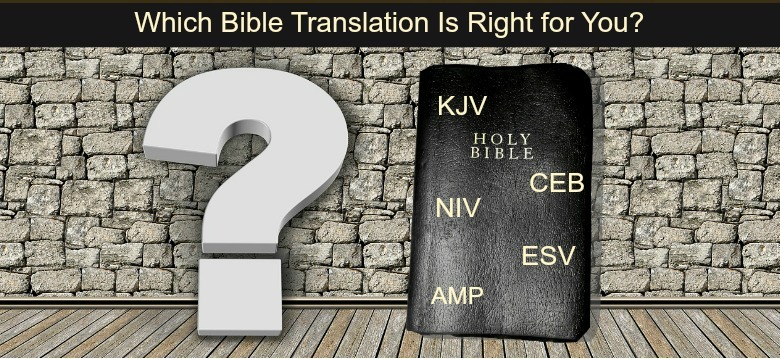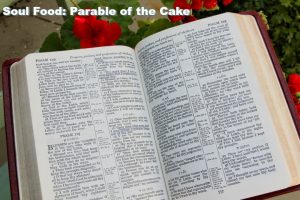Your Preferred Bible Translation Is Personal
The Bible translation that you select is significantly personal. Your selection might be based on the years that you have spent hearing the Bible read from people in the clergy. Your preference might be influenced by a religious denomination or family tradition. Or you might be launching from ground-zero and have no preference or idea of where to start.
There are hundreds of options for English translations of the Bible. There is no way to give an exact number of these translations. There are whole and incomplete direct-from-the-manuscript translations and whole or incomplete paraphrase translations. Throw in revisions of those translations or paraphrases and mix that with Old or New Testament or single book options—you get the picture.
Finding a Bible Translation that Appeals to You
Below are descriptions of twelve of the most popular modern translations of the English Bible. You will find a summary of each version that will guide you to making the choice that is right for you. You might prefer a version that leans more toward a word-for-word translation or thought-for-thought or achieves a balance of the two. You might find that a paraphrase Bible translation that values readability over literal accuracy works best. Whether you prefer contemporary language or traditional, formal language, there is an edition of the Bible that will appeal to you.
What’s most important is that we seek God and desire to have a personal relationship with The Father and His Son Yeshua. God will give His Holy Spirit to His children. And His Holy Spirit will transcend the written word and enable us to understand the truth, “not in words taught by human wisdom but in words taught by the Spirit, expressing spiritual truths in spiritual words.” (1 Corinthians 2:13)
God Will Speak Your Language So that You Can Hear
I love reading the Bible. My preferred version is the New International Version (NIV) 1984 edition. This is the Bible translation that I have read almost exclusively for years. I have read other editions, but the language of the NIV is what I hear when the Spirit speaks to me. I believe that this is because God will speak to you in the language—or version—that you understand. Which means that almost all versions of the Bible are acceptable as long as they are directly translated from the best ancient manuscripts.
So, if you are a veteran reader of the Holy Book, just continue with what you know. Perhaps you will want to mix things up a bit and try a new edition. Or if you are fresh and new to reading the Bible, if there is a stirring in you to read, start now. That stirring is God’s Spirit calling to you, His child.
A Few Facts to Consider about Bible Translations
When reviewing the descriptions of the twelve editions included in this writing, just find the one that speaks to you. And here are a few facts to consider and prevent loss of sleep over which Bible translation is better than another:
- Every single version of the Bible, regardless of religion or language—including those in modern Hebrew or Greek—is a translation.
- No one has seen the original manuscripts from which all BIble translations are compiled. This is because the original manuscripts either no longer exist or are hidden. The earliest versions of Biblical records are not the originals. Every source from which all Bible translations draws are copies themselves; no original manuscript is available to any of the contributors who collaborate and compile the various translations of the Bible.
- Very few non-clergy, non-theologian, non-Biblical scholar people have seen the ancient texts or the Dead Sea Scrolls. Nor can most English-speaking “non-“ people read Hebrew, Greek or Aramaic whether it’s in ancient or modern languages.
- Even with the greatest intentions to remain objective and to eliminate or reduce cultural, religious, or denominational influences, the mere fact that there are so many translations testifies that these influences exist and have led to such a vast selection of editions of the Bible.
- The translators are men. And since no man is perfect no Bible translation can ever be perfect.
- God says that His Spirit will teach us everything that we need to know (Isaiah 54:13, John 6:45, 1 John 2:27, just to name a few). Because this is true, any flaw that man can’t overcome or correct, can and will be perfected by God. God gives us His Spirit so that we can worship Him in Spirit and in Truth.
Word-for-Word Bible Translations
Amplified Bible
The Amplified Bible (AMP) takes both word meaning and context into account. The goal is to accurately translate the original text from one language to another. The AMP uses multiple English word equivalents to key Hebrew and Greek words for relevance and clarity.
This word-for-word translation with amplification of word meanings appeals to those who are looking to explore the words in Scripture for deeper analysis.
English Standard Version
The English Standard Version (ESV) is an “essentially literal” translation. The ESV seeks to capture the precise wording of the original manuscripts while maintaining the authentic voice of the Bible authors. The ESV is a classic Bible translation in alignment with conservative traditional versions. The William Tyndale’s New Testament of 1526 is the forerunner of the translations that resulted in the King James Version of 1611 (KJV), the English Revised Version of 1885 (RV), the American Standard Version of 1901 (ASV), and the Revised Standard Version of 1952 and 1971 (RSV).
Suitable for readers of all ages, the ESV is one of the fastest growing translations of the Bible.
King James Version
The King James Version (KJV) is the second oldest English Bible translation. It was finished in 1611, 85 years after William Tyndale translated the New Testament into English in 1526. It is a word-for-word translation which sought to render the Bible into language which the people of that time could understand.
The KJV is the best-known version among Christians in general and the most widely used translation among conservative Christians.
New American Standard Bible
The New American Standard Bible (NASB) is the updated version of its forerunner, the American Standard Version which was written in 1901. The NASB is considered the most literal translation of Bible versions. This word-for-word translation seeks to preserve fidelity to the actual words of the original Hebrew and Greek manuscripts while rendering grammar and terminology in contemporary English.
The NASB is widely used by conservative evangelical Protestant Christians.
New King James Version
The New King James Version (NKJV) is translated from the original Hebrew, Greek and Aramaic texts and is a modern language update to the King James Version (KJV). The NKJV is a collaborative effort among Bible scholars, church leaders and lay Christians. These contributors worked to achieve a completely new, modern translation that retained the foundational principals and poetic voice of the original KJV.
The NKJV provides a readable translation of the Bible that is also great for study.
Dynamic Equivalence or Balanced Bible Translations
Christian Standard Bible
The Christian Standard Bible (CSB) combines word-for-word rendering and dynamic thought to achieve Optimal Equivalence. This translation philosophy seeks to balance linguistic precision to the original languages and readability in contemporary English.
The CSB is suitable for personal study, public reading, and sermon preparation.
New International Version
The vision for the New International Version (NIV) started with one man, Howard Long, but grew into a collaborative effort that traversed the lines of denominational and international divisions. The contributors to the NIV started from scratch and created this Bible translation using the original Hebrew, Greek and Aramaic texts.
The NIV balances word-for-word accuracy and though-for-thought clarity. The result is a blend of faithfulness to the original documents and understanding of the meaning of the writings.
New Revised Standard Version
The New Revised Standard Version (NRSV) translation was developed through the collaboration of Protestant denominations, the Roman Catholic Church, the Greek Orthodox Church, and a Jewish scholar. The NSRV has three formats: a standard edition with or without the Apocrypha; a Roman Catholic Edition that includes the Apocrypha; and The Common Bible which includes all books that belong to the Protestant, Roman Catholic, and Orthodox canons.
The NRSV is an ecumenical translation which means that it represents different Christian churches. This version combines word-for-word and thought-for-thought translation into modern English.
Child-Friendly or Simple Language Bible Translations
Contemporary English Version
The Contemporary English Version (CEV) is translated from original manuscripts. The translators of the CEV followed three principles when they compiled this version of the Bible:
- must be understood by people without stumbling in speech
- must be understood by those with little or no comprehension of “Bible” language
- must be understood by all.
The CEV is designed to be easily read by children, English-as-second-language readers, and those who prefer a more contemporary form of the Bible.
International Children’s Bible
The International Children’s Bible (ICB) is translated from the original Hebrew and Greek languages into modern language that is accessible to children. It is not a storybook or paraphrase Bible. The ICB takes its cues from the original Greek manuscripts which were written in simple everyday language. Thus, the ICB uses short, uncomplicated sentences, consistent names, and clear statements to make this version easy to read and understand.
This is a thought-for-thought translation that is one of the most easily read and understood versions of the Bible. The ICB is the first Bible produced for children.
Thought-for-Thought Bible Translation
New Living Translation
The New Living Translation (NLT) was developed from the original Hebrew, Aramaic and Greek manuscripts. The NLT conveys the meaning of the writings in the Bible through modern language. This thought-for-thought translation uses natural, everyday English to achieve a version that is easy to read and understand while being sensitive to the accuracy of the meaning of the original writings.
The meaning of the messages in the Bible delivered through natural language makes the NLT an appealing option for adults and children.
Paraphrase Bible Translation
The Message
The Message was created and translated by Eugene Patterson in segments from 1993 to 2002. He started with the New Testament. His primary goal was to engage his audience by capturing the tone of the text and the conversational feel of the original Greek language. He strived for the spirit of the original writings to engage people in the reading process and help them understand what they read.
The Message is not a study Bible; it is a “reading Bible.” The verse numbers have been left out—the original documents do not have verse numbers—to facilitate the author’s goal to create a book that is easy and enjoyable to read.
God’s Word is the Seed that He Sows
Reading the Bible is important in our relationship and walk with God. The Bible is full of scripture, God’s words. “And all scripture is God-breathed and is useful for teaching, rebuking, correcting and training in righteousness…” (1 Timothy 3:16).
God’s word is the seed that He sows, and His word will bud, blossom and produce an abundant harvest in us:
Isaiah 52:10-11: “As the rain and the snow come down from heaven, and do not return to it without watering the earth and making it bud and flourish, so that it yields seed for the sower and bread for the eater, so is My word that goes out from My mouth: It will not return to Me empty, but will accomplish what I desire and achieve the purpose for which I sent it.”
The Holy Spirit Will Purify Any Bible Translation
The Bible is the best written work that has ever been created. But the best writing that God does is on the human heart and in the human mind (Jeremiah 31:33). This is where He sows his seed. This is where His Word is perfected. This is where no translation is needed. God writes in our minds and on our hearts the untranslated, direct from the source, perfect, divine truth.
So just read. Reading the Bible will enhance your experience in learning about God and getting to know Him and His Son Yeshua. And God’s Holy Spirit will do the work of transforming the work of man to the purity of Spiritual truth.
Related Posts:
Is the Bible God’s Love Letter to Us?
Parable of the Cake – Remaining Faithful to God’s Word
Power of Prayer: Parable of the Cake
Agape Love: Parable of the Cake
Soul Food: Parable of the Cake





















